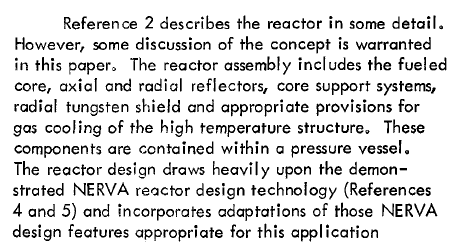chimeric oncogene
ACCESS: Secret
- Joined
- 23 May 2019
- Messages
- 347
- Reaction score
- 429
While virtually all maritime nuclear reactors (save the Soviet Alfas and Papas, which ran on lead-cooled fast reactors with a steam secondary circuit) were light water PWRs, other reactor designs have been prototyped which may be of use for maritime nuclear propulsion.
Concepts include direct power generation from the primary circuit, such as in supercritical water reactors, direct cycle gas-cooled reactors (AKA direct cycle nuclear gas turbines, as proposed for nuclear aircraft), and closed loop gas-cooled reactors.
Power generation can be obtained from the secondary circuit, such as in liquid-metal cooled reactors with a gas (direct or closed) or steam secondary cycle, as well as conventional PWRs (AFAIK).
I suspect that in any case, seawater is the best option for a tertiary circuit. One could consider using air (as in a direct cycle nuclear gas turbine), but that seems silly given the much better properties of water as a coolant; you might as well close the primary circuit loop and make environmentalists happy.
Given the higher power density of some of these proposals, particularly nuclear gas turbines, which were developed for aircraft, such reactors may be more compact than traditional PWRs, and more amenable for use in smaller surface combatants e.g. destroyers, frigates, corvettes, hydrofoil missile boats (as conventionally powered gas turbines are today, while PWRs are not). They thus appear to the interested amateur highly attractive for maritime nuclear propulsion from a technical standpoint.
PWR-based maritime nuclear propulsion, at present, has not been adopted because it is neither cost-effective nor necessary nor politically/environmentally palatable. It is apparent that such advanced reactors would likely be more troublesome than PWRs, and might even require more frequent refueling due to higher power density. However, these difficulties do not appear insurmountable under circumstances of a different economic and technological base, such as in a nuclear economy. I am curious to learn more about the relevant feasibilities, technical and operational concerns, benefits (if any), and tradeoffs of such advanced reactors.
Such reactors have been discussed in brief as part of other threads, but I have found no dedicated thread for this discussion.

Concepts include direct power generation from the primary circuit, such as in supercritical water reactors, direct cycle gas-cooled reactors (AKA direct cycle nuclear gas turbines, as proposed for nuclear aircraft), and closed loop gas-cooled reactors.
Power generation can be obtained from the secondary circuit, such as in liquid-metal cooled reactors with a gas (direct or closed) or steam secondary cycle, as well as conventional PWRs (AFAIK).
I suspect that in any case, seawater is the best option for a tertiary circuit. One could consider using air (as in a direct cycle nuclear gas turbine), but that seems silly given the much better properties of water as a coolant; you might as well close the primary circuit loop and make environmentalists happy.
Given the higher power density of some of these proposals, particularly nuclear gas turbines, which were developed for aircraft, such reactors may be more compact than traditional PWRs, and more amenable for use in smaller surface combatants e.g. destroyers, frigates, corvettes, hydrofoil missile boats (as conventionally powered gas turbines are today, while PWRs are not). They thus appear to the interested amateur highly attractive for maritime nuclear propulsion from a technical standpoint.
PWR-based maritime nuclear propulsion, at present, has not been adopted because it is neither cost-effective nor necessary nor politically/environmentally palatable. It is apparent that such advanced reactors would likely be more troublesome than PWRs, and might even require more frequent refueling due to higher power density. However, these difficulties do not appear insurmountable under circumstances of a different economic and technological base, such as in a nuclear economy. I am curious to learn more about the relevant feasibilities, technical and operational concerns, benefits (if any), and tradeoffs of such advanced reactors.
Such reactors have been discussed in brief as part of other threads, but I have found no dedicated thread for this discussion.

Last edited:





